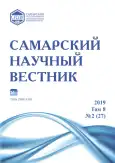Ecological and coenotical structure of the Regional Natural Monument «Chelyabinsk city pine forest» vegetation
- Authors: Nazarenko N.N.1, Novgorodova M.D.1
-
Affiliations:
- South Ural State Humanitarian Pedagogical University
- Issue: Vol 8, No 2 (2019)
- Pages: 38-44
- Section: 03.02.00 – General Biology
- URL: https://journals.rcsi.science/2309-4370/article/view/34295
- DOI: https://doi.org/10.17816/snv201982107
- ID: 34295
Cite item
Full Text
Abstract
The following paper deals with the ecological and coenotical structure of the Regional Natural Monument «Chelyabinsk city pine forest» vegetation. The estimation was done by a cluster analysis with Sorensen-Chekanovsky (Bray-Curtis) distance measure and a flexible beta group linkage method - by non-metric multidimensional scaling, phytoindication and general discriminant analysis algorithms. The flora and coenotical structure of Chelyabinsk city pine forest plant communities are characterized by significant anthropogenic transformation. Forest-margin and meadow, ruderal and synanthropic species are insinuating and naturalizing in pine forest communities actively and supplanting typical pine forest species off communities. The studied pine forest flora synanthropic index is 32 percent. 15 plant associations were detected; its flora, dominant and constant species, coenotical structure and biotopes were characterized by principal ecological factors. The biotopes series of ecological factors replacement were identified. Biotopes series are specified by forest stand ecological structure, that determining ecological regime changes from semi-light to semi-shade and from more arid to more damp. Also biotopes form series from wet more variable moistening bad-aerated not-acid and salt enriched soils to acid aerated poor soils with contrast arid moistening. The detected Chelyabinsk city pine forest biotopes are characterized by not so fluctuation of principal ecological factors.
Full Text
##article.viewOnOriginalSite##About the authors
Nazar Nikolayevich Nazarenko
South Ural State Humanitarian Pedagogical University
Email: nnazarenko@hotmail.com
doctor of biological sciences, professor of Chemistry, Ecology and Chemistry Methodology Department
Russian Federation, ChelyabinskMaria Dmitrievna Novgorodova
South Ural State Humanitarian Pedagogical University
Author for correspondence.
Email: jonp@mail.ru
student of Natural Sciences and Technologies Faculty
Russian Federation, ChelyabinskReferences
- Потапова Н.А., Назырова Р.И., Забелина Н.М., Исаева-Петрова Л.С., Коротков В.Н., Очагов Д.М. Сводный список особо охраняемых природных территорий Российской Федерации (справочник) / отв. ред. Д.М. Очагов. Ч. 2. М.: ВНИИприроды, 2006. 364 с.
- Сысоев А.Д. Челябинский бор. Челябинск: Южно-Уральское книжное издательство, 1968. 48 с.
- Самарин В.П., Волгин А.М. Ленточные боры Челябинской области и некоторые вопросы их сохранения // Флора и растительность Урала и пути их охраны. Челябинск: ЧГПИ, 1983. С. 15-21.
- Строкова Н.Л., Мейлах Э.В. Челябинский городской бор как рекреационный ресурс, рекреационная дигрессия бора // Проблемы рационального природопользования и устойчивого развития Челябинской области: сборник научных статей конф. 22-23 декабря 1999 г., г. Челябинск, Российская Федерация. Челябинск: ЧГПИ, 1999. С. 73-75.
- Белов С.А. Влияние рекреационной доступности на степень антропогенной трансформации Челябинского городского бора // Строительство и экология: теория, практика, инновации: сборник докладов I междунар. науч.-практ. конф. 09-10 марта 2015 г., г. Челябинск, Российская Федерация. Челябинск: ПИРС, 2015. С. 264-268.
- Беляев С.А., Манторова Г.Ф. Рекреационная нагрузка и благоустройство функциональных зон Челябинского городского бора // Наука ЮУрГУ: мат-лы 70-й науч. конф. 25 апреля - 4 мая 2018 г., г. Челябинск, Российская Федерация. Челябинск: Издательский центр ЮУрГУ, 2018. С. 47-54.
- Мискина Л.В. Челябинский городской бор как природно-рекреационный парк // Проблемы географии Урала и сопредельных территорий: мат-лы IV всерос. науч.-практ. конф. с междунар. участием. 19-21 мая 2016 г., г. Челябинск, Российская Федерация. Челябинск: Край Ра, 2016. С. 183-185.
- Методы изучения лесных сообществ. СПб.: НИИ Химии СПбГУ, 2002. 240 с.
- Ханина Л.Г., Смирнов В.Э., Бобровский М.В. Новый метод анализа лесной растительности с использованием многомерной статистики (на примере заповедника Калужские засеки) // Бюллетень МОИП. Отд. биологический. 2002. Т. 107, вып. 1. С. 40-47.
- McCune B., Grace J.B. Analysis of Ecological Communities. MjM SoftWare Design, 2002. 300 p.
- Hardle W., Simar L., Applied multivariate statistical analysis. Springer, Berlin-Heidelberg. 2007. 486 p.
- Legendre L., Legendre P. Numerical ecology. Amsterdam: Elsevier Science B.V., 1998. 853 p.
- Didukh Ya.P. The ecological scales for the species of Ukrainian flora and their use in synphytoindication. Kyiv: Phytosociocentre, 2011. 176 p.
- Persson S. Ecological indicator values as an aid in the interpretation of ordination diagrams // Journal of Ecology. 1981. Vol. 69, № 1. P. 71-84.
- Заугольнова Л.Б. Иерархический подход к анализу лесной растительности малого речного бассейна (на примере Приокско-террасного заповедника) // Ботанический журнал. 1999. Т. 84, № 8. С. 42-56.
- Бурда Р.И. Антропогенная трансформация флоры. К.: Наукова думка, 1991. 168 с.
- Бельгард А.Л. Степное лесоведение. М.: Лесная промышленность, 1974. 336 с.
- Ильин Е.Н., Назаренко Н.Н. Биотопы лесных насаждений регионального памятника природы «Челябинский городской бор» // Вестник Тамбовского университета. Серия: Естественные и технические науки. 2017. Т. 22, № 5. Ч. 1. С. 896-901.
- Назаренко Н.Н. Разнообразие биотопов ботанического памятника природы «Челябинский городской бор» // Тобольск научный - 2018: мат-лы XV всерос. (с междунар. участием) науч.-практ. конф. (г. Тобольск, 15-16 ноября 2018 г.). Т. 1. Тобольск: ООО ИПЦ «Экспресс», 2018. С. 50-53.
- Терентьев П.В. Метод корреляционных плеяд // Вестник Ленинградского государственного университета. 1959. № 9. С. 137-141.
Supplementary files








